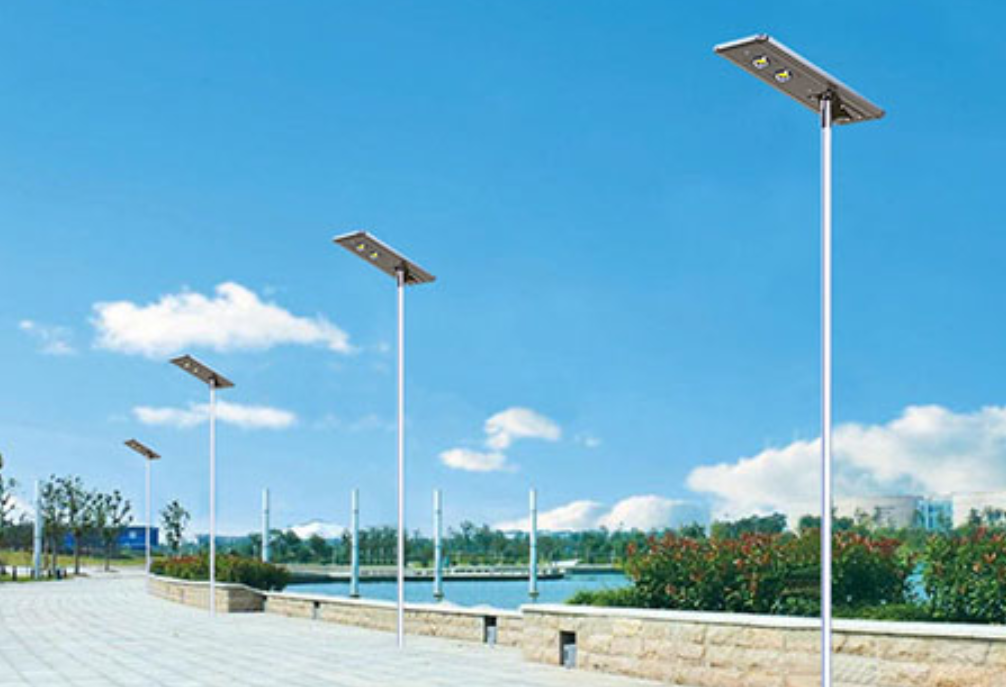What is Street Light?
Street light refer to lamps that provide lighting functions for roads, and generally refer to lamps within the range of street lighting in traffic lighting. Street lights are widely used in various places where lighting is needed.
Fire is the history of human development is an entrepreneurial history pursuing bright, and the use of fire is an important milestone in the progress of human civilization. The bonfires lit by ancient ancestors are the earliest lights.
Constitute
It consists of lamps, wires, light sources, lamp poles, lamp arms, flanges, and foundation embedded parts as a whole.
Types
- According to the height of street lights: high pole lights, middle pole lights, road lights, courtyard lights, lawn lights, underground lights;
- According to the material of street lamp pole: hot-dip galvanized iron street lamp, hot-dip galvanized steel street lamp and stainless steel street light;
- According to the street light source: sodium lamp street lamp, LED street lamp, energy-saving street lamp, new type Xenon street light.
- Divided by shape: Chinese lamp, antique lamp, landscape lamp, single-arm street lamp, double-arm street light.
- According to the power supply mode: city circuit lights, solar street lights, wind and solar hybrid street lights.
Street lights involve lighting technology and are suitable for street lights. The purpose is to design a high-efficiency electronic energy-saving street lamp with long life, low power consumption, high power factor and low current harmonic content. The high-efficiency electronic energy-saving street lamp includes the power grid high-voltage discharge branch R1, C1, rectifier bridge D1-D4, power factor correction branch C2, D5, D6, high and intermediate frequency glitch filter branch L1, L3, and high-frequency oscillation circuit connected in sequence BG1-BG2, start branch L2, C7 and lamp T; compared with previous street lamps, it can save 80% of electricity; harmonic content THD<25%, extending lamp life up to 3-4 times.
Classification
Street lamps are usually classified according to the shape of the light emitted. For the specific classification method, the International Commission on Illumination (CIE) recommends three items: projection, expansion, and control.
① Projection. Indicates the degree of diffusion of the light emitted by the lamp along the longitudinal direction of the road, divided into three types: short, medium and long.
②Expansion. Indicates the degree of spread of the light emitted by the lamp in the lateral direction of the road, divided into three types: narrow, normal and wide.
③Control. Indicates the degree of glare control of the lamp, which can be divided into three types: limited, medium, and strict.
There are several ways to install street lamps, such as bracket type, tall type, straight pole type, suspension cable type and wall suction type.
What is HPS Street Light?
Brief Introduction
The sodium lamp uses sodium vapor discharge to produce an electric light source of visible light. Sodium lamps are divided into low-pressure sodium lamps and high-pressure sodium lamps. The working vapor pressure of low pressure sodium lamp does not exceed a few Pa. The discharge radiation of the low pressure sodium lamp is concentrated on the two double D spectral lines of 589.0 nm and 589.6 nm, which are very close to the highest value of the human visual curve (555 nm), so its luminous efficiency is extremely high.
The working vapor pressure of the high pressure sodium lamp is greater than 0.01 MPa. The high-pressure sodium lamp is developed for the shortcomings of low-pressure sodium lamp such as strong monochromaticity, poor color rendering, and long discharge tube.
Working Principle
When the bulb is started, an arc is generated between the electrodes at both ends of the arc tube. Due to the high temperature of the arc, the sodium amalgam in the tube is heated and evaporated into mercury vapor and sodium vapor. The electrons emitted by the cathode hit the discharge material during the movement to the anode.
The atoms gain energy to produce ionization excitation, and then return from the excited state to the stable state; or change from the ionized state to the excited state, and then return to the ground state in an infinite loop. The excess energy is released in the form of light radiation to produce light.
The vapor pressure of the discharge material in the high-pressure sodium lamp is very high, that is, the density of sodium atoms is high, and the number of collisions between electrons and sodium atoms is frequent, which broadens the resonance radiation spectrum and appears other visible spectrum radiation, so the light color of the high-pressure sodium lamp is better than Low pressure sodium lamp.
The sodium lamp is a high-intensity gas discharge bulb. Due to the negative resistance characteristics of the gas discharge bulb, if the bulb is connected to the power grid alone, its working state is unstable. As the discharge process continues, it will cause the current in the circuit to rise indefinitely, and finally until the light or the circuit Parts were burned by overcurrent.
What is LED Street Light?
Brief Introduction
LED street lights refer to street lights made with LED light sources, which have the unique advantages of high efficiency, safety, energy saving, environmental protection, long life, fast response speed, and high color rendering index. They are of great significance to energy saving in urban lighting.
The difference between LED street lights and conventional street lights is that the LED light source adopts low-voltage DC power supply, high-efficiency white light synthesized by GaN-based power blue LED and yellow, which has high efficiency, safety, energy saving, environmental protection, long life, fast response speed, high color rendering index, etc. Unique advantages, can be widely used on roads. The outer cover can be made, with high temperature resistance up to 135 degrees and low temperature resistance up to -45 degrees.
Why We Choose LED Street Light Instead of HPS?
- The characteristics of the LED street lamp itself-the one-way light, no light diffusion, to ensure the light efficiency,
- The LED street light has a unique secondary optical design, which irradiates the light of the LED street lamp to the area that needs to be illuminated, and further improves the light efficiency to achieve energy saving purposes.
- The LED has reached 110-130lm/W, and there is still a lot of room for development, with a theoretical value of 360lm/W. The luminous efficiency of high-pressure sodium lamps increases with the increase of power. Therefore, the overall luminous efficiency of LED street lamps is stronger than that of high-pressure sodium lamps.
- The light color rendering of LED street lamps is much higher than that of high pressure sodium lamps. The color rendering index of high pressure sodium lamps is only about 23, while the color rendering index of LED street lamps is above 75. From the perspective of visual psychology, the same brightness can be achieved. Reduced by more than 20% than high-pressure sodium lamps,
- The light decay is small, the light decay in a year is less than 3%, and it can still meet the road requirements after 10 years of use, while the high-pressure sodium lamp has a large decay, which has dropped by more than 30% in about a year. Therefore, the design of the power of LED street lights Can be lower than high-pressure sodium lamps,

- The LED street lamp has an automatic control energy-saving device, which can achieve the greatest possible reduction in power and energy saving under the condition of meeting the lighting requirements of different periods. It can realize computer dimming, time period control, light control, temperature control, automatic inspection and other humanized functions,
- Long lifespan: It can be used for more than 50,000 hours and provides a 5-year quality guarantee.
- High luminous efficiency: Using chips ≥100LM, it can save more than 75% energy compared with traditional high-pressure sodium lamps.
- Easy installation: no need to add buried cables, no rectifiers, etc., directly connect to the lamp pole or nest the light source into the original lamp housing,
- Excellent heat dissipation control: The temperature in summer is controlled below 45 degrees, and passive heat dissipation is adopted, and the heat dissipation in summer is insufficient.
- Reliable quality: All circuit power supplies use high-quality components, and each LED has individual overcurrent protection, so there is no need to worry about damage.
- Uniform light color: No lens is added, and uniform light color is not sacrificed to increase brightness, so as to ensure uniform light color without aperture.
- LED does not contain harmful metal mercury, and will not cause harm to the environment when it is scrapped.
- Low maintenance cost: Compared with traditional street lamps, the maintenance cost of LED street lamps is extremely low. After comparison, all input costs can be recovered in less than 5 years.
Combining the above principles, the energy-saving effect is significant, and LEDs can save more than 60% of electricity instead of high-pressure sodium lamps.
How Much Does LED Street Lights Save Energy Cost per Year?
The LED intelligent street light fully considers the actual situation of urban road lighting, and uses the single-chip control technology to dynamically and intelligently manage the street light illuminance to realize the humanization of the street light. Because LED street lights have the characteristics of extremely fast transient response that other street lights do not have, it is very easy to use KHZ-level pulse width modulation (PWM) on the circuit to adjust the duty cycle of LED street lights (for example, light within 1ms) 0.5ms on and 0.5ms off, the brightness is 50% of the full brightness), which adjusts the overall brightness of the lamp.
Working at such a high frequency, there will be no stroboscopic phenomenon. By setting the lamps, the street lights can maintain strong illuminance during busy hours, and the automatic dimming will start in the middle of the night when the traffic is scarce to keep the street lights low Illumination of lighting. You can also use the built-in programmer to manually set the illuminance level and set the intensity and weak illuminance time-length ratio control according to the prosperity of different cities, the actual lighting situation, and the traffic flow. In the future, the street lights can be periodically executed according to the new settings. . That is to realize the personalization of local road lighting.
According to the current status of international street lighting, pedestrians and vehicles on the roads are gradually scarce after 9 o’clock in the evening in small cities and 2 o’clock in the morning in large and medium-sized cities. From this time until 6 o’clock in the morning, it is obviously unnecessary to maintain high illuminance on such a low-traffic road.
It is understood that urban public lighting accounts for 30% of the international lighting power consumption, about 43.9 billion kWh. Based on the average electricity price of $0.09/kWh, the annual expenditure is 28.5 billion US dollars. Today, when municipal expenditures are extremely tight, most cities and regions in the world have almost coincidentally adopted the method of saving money by turning off street lights. This not only leads to uneven distribution of road illumination, but also creates hidden dangers to public security and traffic safety. In addition, the increase of the grid voltage in the second half of the night will damage the life of street lamps, and a large number of lamps need to be replaced every year, so it cannot be regarded as a real energy saving.
Energy saving means saving electricity while lighting the lamp under the guarantee of lighting effect. The main advantage of the above intelligent control is to greatly reduce power consumption, saving power consumption by more than 40%, and avoiding the hidden danger of turning off the lights. For the promotion of high-efficiency and energy-saving intelligent lighting appliances, the effective use of light energy in accordance with the actual lighting situation and the saving of lighting electricity have far-reaching significance.





